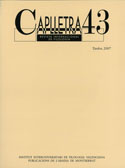"Ut pictura poiesis": text i imatge, mimesi i realitat quant a «Tirant lo Blanch»
DOI:
https://doi.org/10.7203/caplletra.43.4815Keywords:
History of Art, Painting, Iconography, Literature and Society Abstract
Abstract
The relationship between literature and reality in the Middle Ages can be considered from several dimensions. One of the most important cultural elements of the medieval period is the visual representation of reality found it literary texts, not only through the presence of miniatures in the manuscripts, but especially through the description of realia in the same text. The encyclopedic tradition helps to intertwine this close relationship between the outer representativeness and the inwardness of the text, a new interpretation of the Horacian’s ut pictura poiesis. The «Tirant lo Blanch» is a fictional text full of iconic references to contemporary reality, which in this study are made clear visually.
 Downloads
Downloads
Downloads
Published
How to Cite
-
Abstract256
-
PDF (Català)170
Issue
Section
License
Authors submitting work to Caplletra for publication must be the legitimate holder of the usage rights. Legitimacy for the purposes of publishing the work must also include images, tables, diagrams and any other materials that may complement the text, whether they are the author of such material or not.
Copyright: on publishing their work in the journal, the author grants Caplletra. Revista Internacional de Filologia usage rights (reproduction, distribution and public communication) for both the paper printed version and for the electronic version.
All work published in Caplletra is covered by the Creative Commons license type Attribution-NonCommercial-NoDerivatives 4.0 (CC BY-NC-ND 4.0).
RESPONSABILITY
Caplletra. Revista Internacional de Filologia does not necessarily identify with the points of view expressed in the papers it publishes.
Caplletra. Revista Internacional de Filologia accepts no responsibility whatsoever for any eventual infringement of intellectual property rights on the part of authors.






